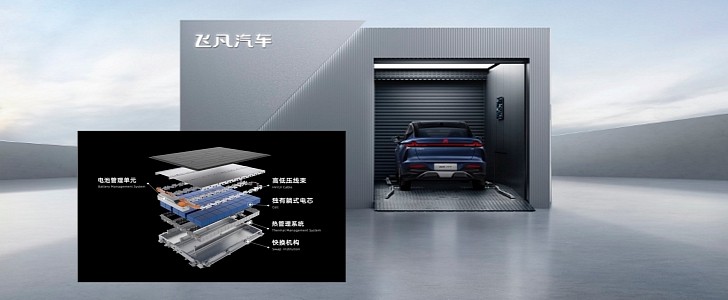We will not blame you if you have never heard about Rising Auto. The Chinese car brand is just one of the several brands SAIC has in the world’s largest market. Another one is MG, which explains why Rising Auto also sells the Marvel R, a vehicle that has the MG badge in Europe. The brand finally caught our attention, not because of its SAIC ramifications but because it made a deal with CATL, Sinopec, and PetroChina to use swappable battery packs – and swap them in fuel stations.
You read that right. Sinopec and PetroChina have more than 50,000 fuel stations across China, and the battery pack swapping stations will be installed in these locations. The first one will be placed at the Shanghai Anting Delivery Center, followed by 39 other stations until the end of the year. In 2023, the partners want to have 300 stations, reaching 3,000 by 2025.
SAIC, CATL, Sinopec, and PetroChina created a new company to take care of battery swapping. Its official name is Shanghai Jieneng Smart Electric New Energy Technology Co., Ltd. You may call it just Jieneng Smart Electric for short, but we suspect its international name to be Rising Power, which is even shorter. The company will make its premiere with the Rising Auto R7, the first one from SAIC’s brand with battery pack swapping capability. In China, Rising Auto is called Feifan.
The new electric SUV was presented as a concept car at the Shanghai Auto Show in 2021, but its world premiere is scheduled for September 27. The R7 is 4.90 meters (192.9 inches) long, 1.93 m (75.8 in) wide, 1.66 m (65.2 in) tall, and has a wheelbase of 2.95 m (116.1 in) that accommodates a 90-kWh battery pack.
The swappable component uses cell-to-pack (CTP) construction and uses what Rising Auto claims to be the first double-layer horizontal cell technology. In other words, it is composed of prismatic cells laid laterally instead of standing up. That allowed Rising Auto to put two layers of these cells in the battery pack and still keep it very thin. That allowed the component to present an energy density of 185 Wh/kg (84 Wh/lbs).
The range is 642 km (399 miles), probably under CLTC (China light-duty vehicle test cycle). With CATL involved in the project, we thought Rising Auto would use Choco-SEBs, the swappable 26.5-kWh battery modules the Chinese battery maker developed.
This is not the only interesting bit about the new battery pack. Thanks to a system called Quick Click, the component is fast to swap: 2 minutes and 30 seconds. NIO’s Power Stations 2.0 do that in 3 minutes.
With Rising Auto using these swappable battery packs, SAIC should expand the idea to other electric vehicles. We would not be surprised if MG vehicles get them in a few years. That would be a way for SAIC to expand Rising Power to Europe. We shall see.
SAIC, CATL, Sinopec, and PetroChina created a new company to take care of battery swapping. Its official name is Shanghai Jieneng Smart Electric New Energy Technology Co., Ltd. You may call it just Jieneng Smart Electric for short, but we suspect its international name to be Rising Power, which is even shorter. The company will make its premiere with the Rising Auto R7, the first one from SAIC’s brand with battery pack swapping capability. In China, Rising Auto is called Feifan.
The new electric SUV was presented as a concept car at the Shanghai Auto Show in 2021, but its world premiere is scheduled for September 27. The R7 is 4.90 meters (192.9 inches) long, 1.93 m (75.8 in) wide, 1.66 m (65.2 in) tall, and has a wheelbase of 2.95 m (116.1 in) that accommodates a 90-kWh battery pack.
The swappable component uses cell-to-pack (CTP) construction and uses what Rising Auto claims to be the first double-layer horizontal cell technology. In other words, it is composed of prismatic cells laid laterally instead of standing up. That allowed Rising Auto to put two layers of these cells in the battery pack and still keep it very thin. That allowed the component to present an energy density of 185 Wh/kg (84 Wh/lbs).
The range is 642 km (399 miles), probably under CLTC (China light-duty vehicle test cycle). With CATL involved in the project, we thought Rising Auto would use Choco-SEBs, the swappable 26.5-kWh battery modules the Chinese battery maker developed.
This is not the only interesting bit about the new battery pack. Thanks to a system called Quick Click, the component is fast to swap: 2 minutes and 30 seconds. NIO’s Power Stations 2.0 do that in 3 minutes.
With Rising Auto using these swappable battery packs, SAIC should expand the idea to other electric vehicles. We would not be surprised if MG vehicles get them in a few years. That would be a way for SAIC to expand Rising Power to Europe. We shall see.






